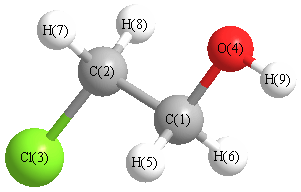Vibrational Frequencies calculated at QCISD(T)/aug-cc-pVDZ
| Mode Number |
Symmetry |
Frequency
(cm-1) |
Scaled Frequency
(cm-1) |
IR Intensities
(km mol-1) |
Raman Act
(Å4/u) |
Dep P |
Dep U |
|---|
| 1 |
A' |
3813 |
3728 |
|
|
|
|
| 2 |
A' |
3091 |
3022 |
|
|
|
|
| 3 |
A' |
3016 |
2949 |
|
|
|
|
| 4 |
A' |
1506 |
1472 |
|
|
|
|
| 5 |
A' |
1476 |
1443 |
|
|
|
|
| 6 |
A' |
1434 |
1402 |
|
|
|
|
| 7 |
A' |
1288 |
1260 |
|
|
|
|
| 8 |
A' |
1229 |
1201 |
|
|
|
|
| 9 |
A' |
1055 |
1032 |
|
|
|
|
| 10 |
A' |
1029 |
1006 |
|
|
|
|
| 11 |
A' |
764 |
747 |
|
|
|
|
| 12 |
A' |
384 |
375 |
|
|
|
|
| 13 |
A' |
246 |
241 |
|
|
|
|
| 14 |
A" |
3161 |
3091 |
|
|
|
|
| 15 |
A" |
3065 |
2997 |
|
|
|
|
| 16 |
A" |
1286 |
1257 |
|
|
|
|
| 17 |
A" |
1191 |
1165 |
|
|
|
|
| 18 |
A" |
1049 |
1026 |
|
|
|
|
| 19 |
A" |
790 |
773 |
|
|
|
|
| 20 |
A" |
239 |
234 |
|
|
|
|
| 21 |
A" |
122 |
119 |
|
|
|
|
Unscaled Zero Point Vibrational Energy (zpe) 15616.1 cm
-1
Scaled (by 0.9778) Zero Point Vibrational Energy (zpe) 15269.4 cm
-1
See section
III.C.1 List or set vibrational scaling factors
to change the scale factors used here.
See section
III.C.2
Calculate a vibrational scaling factor for a given set of molecules
to determine the least squares best scaling factor.
